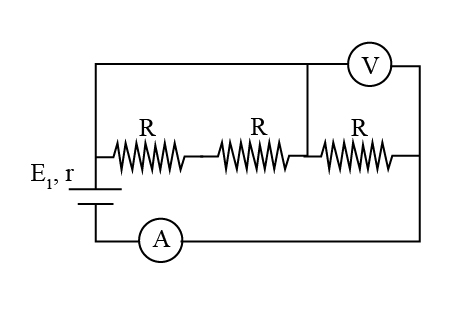
Answer
453.6k+ views
Hint: The above problem can be resolved using the circuit analysis technique and the Kirchhoff’s Voltage rule. The significant calculations to the solution begin with finding the magnitude of the current through the ammeter. Then the current is used to determine the magnitude of voltage in the reading given by the voltmeter.
Complete step by step answer:
The magnitude of EMF is, \[E = 4\;{\rm{V}}\].
The internal resistance is, \[r = 1\;\Omega \].
The resistance is, \[R = 9\;\Omega \].
Considering the loop with the first two resistors, we can say that the current in two resistors will be equal and opposite to. Similarly, in the loop with the last two resistors, the current will be equal and opposite.
In the first resistor, the magnitude of current I flows from left to right.
In the second resistor, the magnitude of current I flows from right to left.
And, in the third resistor, the magnitude of current I flows from left to right.
Therefore, the current flow in the ammeter will be from right to left and the magnitude is
$I_1 = I+I+I$
$I_1 = 3I$
Then applying the KVL rule as,
\[\begin{array}{l}
E = {I_1} \times r + I \times R\\
4\;{\rm{V}} = 3I \times 1\;\Omega + I \times 9\;\Omega \\
I = \dfrac{1}{3}\;{\rm{A}}
\end{array}\]
The ammeter reading is, \[3I = 3 \times \dfrac{1}{3}\;{\rm{A}} = 1\;{\rm{A}}\].
And, the voltmeter reading is,
\[\begin{array}{l}
V = I \times R\\
V = \dfrac{1}{3}\;{\rm{A}} \times {\rm{9}}\;\Omega \\
V = 3\;{\rm{V}}
\end{array}\]
Therefore, the ammeter reading is 1 A and the voltmeter reading is 3 V
So, the correct answers are “Option A and C”.
Note:
To solve such a condition, one must be aware of the basic techniques to resolve the tricky circuit. The various methods like the Kirchhoff’s Current rule, and Kirchhoff’s Voltage rule need to be remembered significantly to resolve the complex circuits. The concepts and the applications for each of the methods need to be analysed firmly.
Complete step by step answer:
The magnitude of EMF is, \[E = 4\;{\rm{V}}\].
The internal resistance is, \[r = 1\;\Omega \].
The resistance is, \[R = 9\;\Omega \].
Considering the loop with the first two resistors, we can say that the current in two resistors will be equal and opposite to. Similarly, in the loop with the last two resistors, the current will be equal and opposite.
In the first resistor, the magnitude of current I flows from left to right.
In the second resistor, the magnitude of current I flows from right to left.
And, in the third resistor, the magnitude of current I flows from left to right.
Therefore, the current flow in the ammeter will be from right to left and the magnitude is
$I_1 = I+I+I$
$I_1 = 3I$
Then applying the KVL rule as,
\[\begin{array}{l}
E = {I_1} \times r + I \times R\\
4\;{\rm{V}} = 3I \times 1\;\Omega + I \times 9\;\Omega \\
I = \dfrac{1}{3}\;{\rm{A}}
\end{array}\]
The ammeter reading is, \[3I = 3 \times \dfrac{1}{3}\;{\rm{A}} = 1\;{\rm{A}}\].
And, the voltmeter reading is,
\[\begin{array}{l}
V = I \times R\\
V = \dfrac{1}{3}\;{\rm{A}} \times {\rm{9}}\;\Omega \\
V = 3\;{\rm{V}}
\end{array}\]
Therefore, the ammeter reading is 1 A and the voltmeter reading is 3 V
So, the correct answers are “Option A and C”.
Note:
To solve such a condition, one must be aware of the basic techniques to resolve the tricky circuit. The various methods like the Kirchhoff’s Current rule, and Kirchhoff’s Voltage rule need to be remembered significantly to resolve the complex circuits. The concepts and the applications for each of the methods need to be analysed firmly.
Recently Updated Pages
Who among the following was the religious guru of class 7 social science CBSE

what is the correct chronological order of the following class 10 social science CBSE

Which of the following was not the actual cause for class 10 social science CBSE

Which of the following statements is not correct A class 10 social science CBSE

Which of the following leaders was not present in the class 10 social science CBSE

Garampani Sanctuary is located at A Diphu Assam B Gangtok class 10 social science CBSE

Trending doubts
Which are the Top 10 Largest Countries of the World?

Fill the blanks with the suitable prepositions 1 The class 9 english CBSE

How do you graph the function fx 4x class 9 maths CBSE

Find the value of the expression given below sin 30circ class 11 maths CBSE

In what year Guru Nanak Dev ji was born A15 April 1469 class 11 social science CBSE

The Equation xxx + 2 is Satisfied when x is Equal to Class 10 Maths

Why is there a time difference of about 5 hours between class 10 social science CBSE

Difference between Prokaryotic cell and Eukaryotic class 11 biology CBSE

What is BLO What is the full form of BLO class 8 social science CBSE





